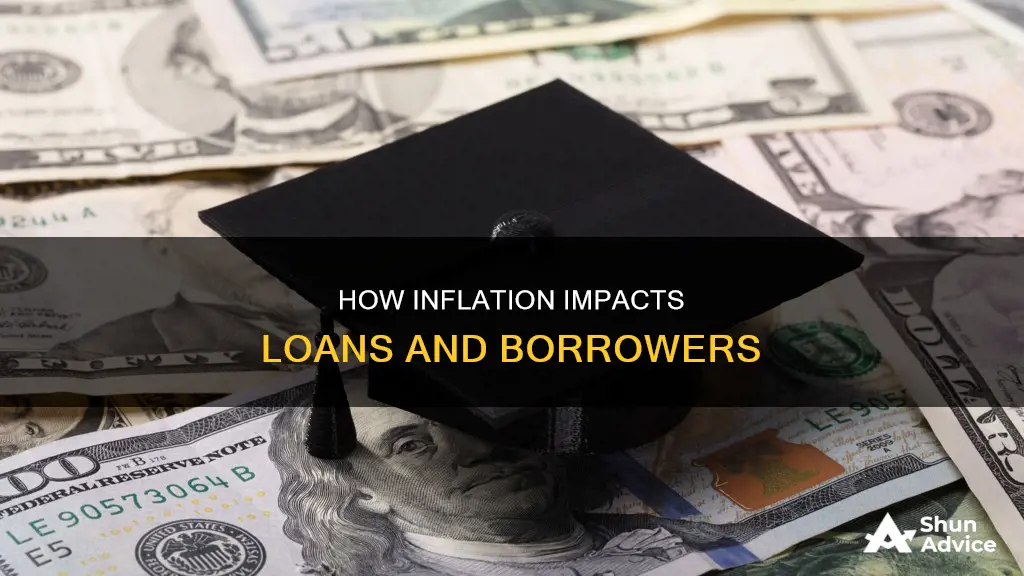
Inflation can affect loans in several ways. Firstly, it can lead to higher interest rates, as central banks may increase rates to curb rising inflation. This makes borrowing more expensive and can reduce demand for loans, impacting economic growth. Inflation also reduces the purchasing power of money, which means borrowers may struggle to make loan payments, especially if their wages are not increasing at the same rate as inflation. On the other hand, inflation can benefit borrowers by allowing them to repay debts with money that has lost value, making it advantageous for them financially. Additionally, revenue-based lending models can shield borrowers from the impact of rising interest rates as repayments are tied to income rather than interest rates. The effects of inflation on loans can vary depending on the type of loan, such as fixed-rate or variable-rate loans, and the economic context.
How Inflation Affects Loans
| Characteristics | Values |
|---|---|
| Interest rates | Inflation leads to higher interest rates on loans, including mortgages and student loans. |
| Demand for loans | Higher interest rates may lead to a slowdown in borrowing as consumers take out fewer loans. |
| Purchasing power | Inflation reduces the purchasing power of money, which means borrowers may have less money to pay off their debts. |
| Default risk | Inflation may increase the risk of default as borrowers may be forced to spend more of their wages on essential expenses. |
| Lender profits | Inflation can benefit lenders by increasing the demand for credit and allowing them to earn higher profits due to higher interest rates. |
| Borrower benefits | Inflation allows borrowers to repay their debts with money that has decreased in value, making it financially beneficial for them. |
| Revenue-based lending | Revenue-based lending is a flexible financing option that is not affected by interest rate fluctuations and is based on the borrower's income. |
What You'll Learn

Inflation and mortgage rates
Inflation can have a significant impact on mortgage rates and the broader housing market. Inflation typically leads to higher interest rates, which in turn affect mortgage rates. This is because inflation devalues a country's currency, reducing its purchasing power. As a result, the cost of borrowing money increases, and lenders demand higher interest rates to compensate for the decreased value of the loan over time.
For example, if the inflation rate is 10%, a mortgage interest rate of 10% would be required just to maintain the value of the loan for the lender. This means that, in periods of high inflation, mortgage interest rates tend to rise, making it more expensive to take out a mortgage loan. This can have a significant impact on households, especially when coupled with rising costs of living.
The relationship between inflation and mortgage rates is complex and influenced by various factors, including central bank policies and the broader economic landscape. Central banks, such as the Federal Reserve in the United States or the Bank of England in the United Kingdom, are responsible for keeping inflation and unemployment rates low through monetary policy. While they do not directly set mortgage interest rates, their decisions on interest rates can influence the rates offered by commercial banks. For example, when the Federal Reserve raises its federal funds rate, mortgage lenders tend to follow suit and raise their rates as well.
The type of mortgage also plays a role in how inflation affects mortgage rates. There are two main types of mortgages: adjustable-rate mortgages (ARMs) and fixed-rate mortgages. ARMs typically have a fixed initial period, ranging from five to ten years, during which the interest rate and monthly payments remain constant. After this period, the interest rate may fluctuate, exposing borrowers to the risk of higher rates. On the other hand, fixed-rate mortgages offer more predictability, with a consistent interest rate for the life of the loan, shielding borrowers from the direct impact of rising interest rates.
Inflation can also bring some benefits to mortgage holders. As inflation erodes the value of money over time, it can reduce the value of outstanding loans. This means that inflation can help pay off part of the outstanding value of the mortgage in real terms, providing some relief to borrowers. Additionally, in the case of buy-to-let mortgages, inflation can improve the long-run financial position of landlords.
Helco Modification: Does ICCU Provide Loan Options?
You may want to see also

Lenders and borrowers
Inflation affects both lenders and borrowers, with benefits and drawbacks for both. Inflation causes a decrease in purchasing power, which means that people may need more time to pay off their debts, allowing the lender to collect interest for a more extended period. However, this could also result in higher default rates. Inflation can also cause higher interest rates, which benefits lenders.
Borrowers with fixed-rate loans can benefit from inflation as they can repay debts with money that has depreciated in worth. This is because inflation causes the value of a currency to decline over time, so cash now is worth more than cash in the future. However, if wages do not increase with inflation, people will experience a decrease in purchasing power, which may leave them with less money to pay off their debts.
Lenders benefit from inflation in several ways, especially when extending new financing. First, higher prices mean that more people want credit to buy big-ticket items, especially if their wages have not increased. This equates to new customers for lenders. Inflation also causes higher interest rates, which means that lenders make more money.
In general, lenders benefit from inflation when they issue new loans, and borrowers benefit from inflation when they have fixed-rate loans. Inflation can also cause a wealth transfer from richer, older households that are creditors to younger, middle-class households with fixed mortgage debt.
Loan Deferment: Does Time Impact Your Options?
You may want to see also

Interest rates
Inflation can affect interest rates in several ways. Firstly, it can lead to higher interest rates on loans, including mortgages and student loans. This is because inflation devalues the currency, resulting in a decrease in its purchasing power. As a result, lenders may increase interest rates to compensate for the reduced value of the loan principal over time. For example, if the inflation rate is 10%, a mortgage interest rate of 10% would be required just to maintain the value of the loan for the lender.
The relationship between inflation and interest rates is complex and depends on various factors, including the type of loan and the economic policies of central banks. For instance, during periods of high inflation, central banks like the Federal Reserve in the United States may increase interest rates to curb inflation. Higher interest rates can discourage borrowing, leading to a slowdown in loan demand. This, in turn, can lead to decreased economic growth, lower prices, and higher unemployment.
On the other hand, fixed-rate loans are not directly affected by changes in interest rates, whether due to inflation or other market factors. With a fixed-rate loan, borrowers pay the same amount throughout the life of the loan, regardless of inflation or interest rate fluctuations. This predictability is often advantageous, especially for business owners financing equipment purchases or those with federal student loans, as it allows them to plan their finances accurately.
It's important to note that the impact of inflation on interest rates can vary depending on the specific loan and economic conditions. While inflation may lead to higher interest rates in some cases, it can also incentivize lenders to offer alternative options to borrowers struggling with increased payments. These options may include suspension or reduction of capital repayments for a fixed period or switching to interest-only payments.
Indian Loans: Buying Property Across State Lines
You may want to see also

Fixed-rate loans
While fixed-rate loans can be beneficial in times of high inflation, as borrowers will be paying back lenders with money that has lost some of its value, it is generally not a good idea to base financing decisions solely on inflation rates. This is because future rates of inflation are hard to predict, and there are other factors at play, such as interest rates, which are influenced by inflation.
Interest rates are determined by lenders based on economic conditions, creditworthiness, the type of loan, and other factors. While inflation does not directly affect interest rates, the two are correlated through indirect means. When inflation is high, the cost of borrowing tends to increase, which can make it more difficult for borrowers to obtain loans.
During periods of high inflation, central banks such as the Federal Reserve may increase interest rates to slow the rate of inflation. This can lead to a slowdown in borrowing as consumers take out fewer loans. However, it is important to note that interest rates on existing fixed-rate loans will not change due to inflation, as these loans have a set interest rate that remains the same over the life of the loan.
In summary, fixed-rate loans can provide stability for borrowers, especially in times of high inflation, as the monthly payments remain the same regardless of the economic climate. However, it is important to consider various factors when making financing decisions, including interest rates, creditworthiness, and economic conditions.
Homestyle Loan: Landscaping Covered?
You may want to see also

Student loan borrowers
Inflation can have both positive and negative effects on student loan borrowers. On the one hand, inflation reduces the purchasing power of money, making it harder for borrowers to repay their loans. As the cost of living increases, people may have to spend more of their income on essential items such as rent, utilities, and groceries, leaving them with less money to put towards their student loan payments. This is especially true if their wages are not increasing at the same rate as inflation.
On the other hand, if borrowers have federal student loans with fixed interest rates, inflation can work in their favour. Inflation effectively devalues debt over time, so the money they use to pay back their loans is worth less than the money they originally borrowed. However, this only helps if their wages are keeping up with or surpassing the inflation rate. If their wages are not increasing at the same rate as inflation, then the devalued debt does not provide much benefit, and they may even find it more challenging to repay their loans.
For borrowers with private student loans, the situation is more complex. Many private student loans have variable interest rates, which can increase over time. As inflation rises, interest rates tend to rise as well, making it more expensive for borrowers to repay their loans. Additionally, inflation can reduce the demand for mortgage-backed bonds, causing a drop in demand that results in higher interest rates for all mortgage types.
Overall, while inflation can have some benefits for student loan borrowers, such as devaluing debt and fixed-rate federal loans, the negative impacts, such as reduced purchasing power and increased interest rates on private loans, can make it more challenging for borrowers to keep up with their loan payments.
Running for Jumbo Loans: Is It Worth the Effort?
You may want to see also
Frequently asked questions
Inflation leads to higher mortgage interest rates as it devalues the currency. This means that the purchasing power of money decreases as inflation increases.
Inflation can cause borrowers to default on their obligations as the cost of living rises, leaving them with less money to pay off debts. Inflation can also lead to higher interest rates, which benefits lenders.
Inflation does not impact fixed-rate loans as the borrower pays the same amount each period throughout the life of the loan, regardless of the inflation rate. However, inflation can make fixed-rate loans more attractive to borrowers as they provide predictability and cost borrowers less over time due to the devaluation of the currency.







